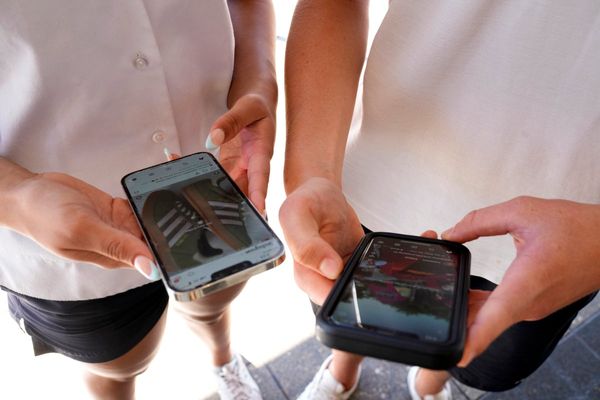
Most Americans live in places where healthy people, including students in schools, can safely take a break from wearing masks under new US guidelines released on Friday.
The Centers for Disease Control and Prevention (CDC) outlined the new set of measures for communities where Covid-19 is easing its grip, with less of a focus on positive test results and more on what is happening at hospitals.
The new system greatly changes the look of the CDC’s risk map and puts more than 70% of the US population in counties where the coronavirus is posing a low or medium threat to hospitals. Those are the people who can stop wearing masks, the agency said.
The agency is still advising that people including schoolchildren wear masks where the risk of Covid-19 is high. That’s the situation in about 37% of US counties, where about 28% of Americans reside.
The new recommendations do not change the requirement to wear masks on public transportation and indoors in airports, train stations and bus stations.
The CDC guidelines for other indoor spaces aren’t binding, meaning cities and institutions even in areas of low risk may set their own rules. And the agency says people with Covid symptoms or who test positive shouldn’t stop wearing masks. But with protection from immunity rising both from vaccination and infection the overall risk of severe disease is now generally lower, the CDC said.
“Anybody is certainly welcome to wear a mask at any time if they feel safer wearing a mask,” the CDC director, Dr Rochelle Walensky, said in a news briefing. “We want to make sure our hospitals are OK and people are not coming in with severe disease … Anyone can go to the CDC website, find out the volume of disease in their community and make that decision.”
Since July, CDC transmission-prevention guidance to communities has focused on two measures: the rate of new cases and the percentage of positive test results over the previous week.
Based on those measures, agency officials advised people to wear masks indoors in counties where spread of the virus was deemed substantial or high. This week, more than 3,000 of the nation’s more than 3,200 counties greater than 95% were listed as having substantial or high transmission.
That guidance has increasingly been ignored, however, with states, cities, counties and school districts across the US announcing plans to drop mask mandates amid declining Covid-19 cases, hospitalizations and deaths.
With many Americans already taking off their masks, the CDC shift won’t make much practical difference for now, said Andrew Noymer, a public health professor at the University of California, Irvine. But it will help when the next wave of infection a likelihood in the fall or winter starts threatening hospital capacity again, he said.
“There will be more waves of Covid. And so I think it makes sense to give people a break from masking,” Noymer said. “If we have continual masking orders, they might become a total joke by the time we really need them again.”
The CDC is also offering a color-coded map with counties designated orange, yellow or green to help guide local officials and residents. In green counties, local officials can drop any indoor masking rules. Yellow means people at high risk for severe disease should be cautious. Orange designates places where the CDC suggests masking should be universal.
How a county comes to be designated green, yellow or orange will depend on its rate of new hospital admissions, the share of staffed hospital beds occupied by Covid patients and the rate of new cases in the community.
Although cases, hospitalizations and deaths from the Omicron coronavirus variant have been falling across the US, a subvariant has emerged as even more transmissible than its predecessors.
In a Danish study conducted among 8,500 households between December and January, researchers found that people infected with the BA.2 subvariant were approximately 33% more likely to infect others compared with those infected with the BA.1 variant.
Frederick Plesner, the lead study author, also said: “If you have been exposed to Omicron BA.2 in your household, you have 39% probability of being infected within seven days. If you instead had been exposed to BA.1, the probability is 29%.”
At @CDCgov, we have been analyzing our #COVID19 data and shifting our focus to preventing the most severe outcomes and minimizing healthcare strain.🧵
— Rochelle Walensky, MD, MPH (@CDCDirector) February 24, 2022
Mask requirements already have ended in most of the US. Los Angeles on Friday began allowing people to remove their masks while indoors if they are vaccinated, and indoor mask mandates in Washington state and Oregon will be lifted in March.
In a sign of the political divisions over masks, Florida’s governor on Thursday announced new recommendations called “Buck the CDC” that actually discourage mask wearing.
State health officials are generally pleased with the new guidance and “excited with how this is being rolled out”, said Dr Marcus Plescia of the Association of State and Territorial Health Officials.
“This is the way we need to go. I think this is taking us forward with a new direction going on in the pandemic,” Plescia said. “But we’re still focusing on safety. We’re still focusing on preventing death and illness.”
The CDC said the new system will be useful in predicting future surges and urged communities with wastewater surveillance systems to use that data too.
“If or when new variants emerge or the virus surges, we have more ways to protect ourselves and our communities than ever before,” Walensky said.







